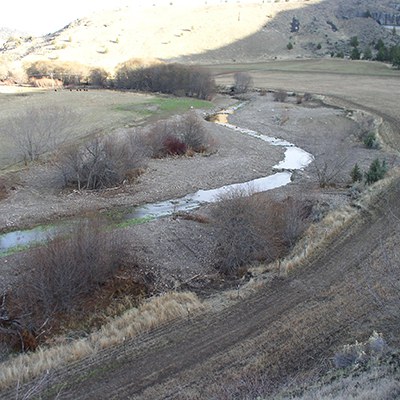In the conservation realm, restoration projects take decades. From planning to execution, then following up, this work is part of the long game. The benefits can be monumental, however. Such is the case for Trout Creek and Antelope Creek. These ribbons of life in the dry sagebrush shrublands outside of Madras (including at Priday Ranch) have sprung back to life after decades of work done by the Oregon Department of Fish and Wildlife (ODFW).
Back in 1986, ODFW started their first restoration work along Trout Creek. It started small, just some enclosure fencing to lessen the impacts of cattle in and around the creek. Some juniper logs were added to the creek as well, to prevent erosion. For 15 years, cattle had spots along Trout Creek where they could get water, while other areas on the creek were protected by the fencing. Hay was grown in fields nearby, using irrigation from the creek. As time passed, though, a vision of a more fully restored creek was starting to be contemplated.
Of course, no creek restoration project is complete without native vegetation. Along Trout Creek, a grass and wildflower seed mix was used—flax, blanketflower, mule’s ear, and balsamroot were sowed along the banks of the creek. Alders, willows, cottonwoods, and dogwoods were hand planted and started to take root. Shrubs like elderberry, serviceberry, and Wood’s rose were also added to the mix. At Antelope Creek, which was restored in 2009, a piece of equipment known as “the stinger” was used to plant the banks, since they couldn’t reach the area to hand plant.
The results of decades of work have been tremendous. According to Tom, there had been almost no beaver activity prior to the restoration work starting in 2004. Now, “beaver activity is off the charts,” says Tom. What exactly does that mean? In 2018, an incredible 75 beaver dams and four beaver lodges were counted in 1.1 miles of Antelope Creek! Now those are some busy beavers!
These beaver dams have also changed the creek. Small pools have encouraged more waterfowl to call this area home. The dams have also created a larger variety of habitats on and around the creek. In addition, creekside vegetation has increased the number of songbirds and migratory birds. The visual change in the creek--especially the amount of vegetation along its banks--has been astounding. Watch the video below to see how Trout Creek has changed over the years.
And then there’s the fish. Most people who fish in Oregon know about Trout Creek. In the summer, steelhead that have returned from the ocean hang out in the Deschutes River. From mid-January to early May, they make their move, heading upstream to spawn. Of the steelhead that go up Sherars Falls on the Deschutes River, 25% make their way up Trout Creek. For those who don’t always have fish on the brain, this is a really incredible number! It makes Trout Creek the largest producer of steelhead in the Deschutes River system.
Trout Creek and Antelope Creek are just two examples of the impact that restoration work can have in our dry home of Central Oregon. With more than six miles of Trout Creek meandering through Priday Ranch, it is sure to be a home for many types of wildlife in the decades to come.
Learn more:
- Priday Ranch Virtual Tour
- Looking at the Whychus Creek Restoration: Four Years Later
- Restoration and Humanism in the Anthropocene


